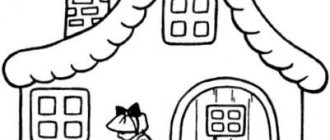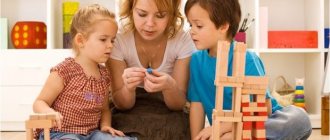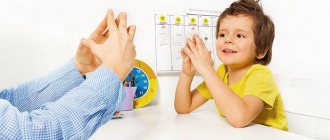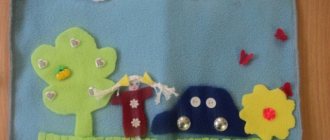One of the important features of a child in the future is the development of thinking today. It is important to start paying attention to this as early as possible.
There is such a thing as a “sensitive period”. This is the optimal stage for developing a particular skill. For children, the period when the foundation is laid is from 1 year to 7 years.
In the article we will talk about the stages of development of thinking in children, methods, and the connection of thinking with other skills.
Features of thinking in preschool age
The brain of a preschooler is mobile and malleable, open to new knowledge. That is why useful habits, the desire to engage in sports, music, theater and art are laid precisely in the preschool period.
In order for a child to analyze and think, it is necessary to constantly set new tasks for him, as well as modernize and complicate the skills he has already acquired.
There are several factors that have a strong influence on a child’s thinking:
- Circle of friends. The older the child, the more children and adults there should be around him. Kindergartens, clubs and sections help with this. The child must observe different behavior patterns of both adults and children.
- Speech development. The child learns to construct sentences and express his thoughts.
- Formation of an analytical worldview. Preschool children are characterized by paying attention to shapes, color, size, spatial arrangement and time frames.
- Acquiring skills and abilities. The child learns to retell, read syllables, and sing.
- Formation of personal qualities. Character, adaptability, initiative, organization - all this is formed as a result of educational activities.
- Formation of self-esteem. A developed child is able to evaluate himself.
- The emergence of self-control. The child learns to manage his behavior and actions.
How to develop preschool children - said Maya Makieva, child psychotherapist
Preschool children actively explore the world and therefore have great curiosity about everything that happens around them. They greedily absorb all the information that adults offer them, as they dream of growing up quickly, becoming smart and strong. Therefore, it is simply impossible to overestimate the role of parents in shaping the child’s thinking.
Games are of great importance in a child's life. It is during play that the most rapid and high-quality development of the child’s imagination occurs, the active work of all thought processes and the assimilation of new information, since the child wants to learn and do something new through play. It is through the game that parents have the opportunity to convey important information to the child, form the values and rules of life for their child, since in the game the child is ready to listen and hear you.
This article presents excellent options for short-term games that will allow you to develop all types of thinking, diversify your communication with your child, as well as spend time with him with benefit and interest. But remember that these games must be strictly dosed, and if you see that the child is starting to get tired, end the game on time.
Stages of development of thinking
- visually effective;
- visual-figurative;
- verbal-logical.
Visual and effective thinking is formed at the age of 1-3 years. When, as a result of his actions, a child, without realizing it, draws conclusions “for the future.” And proof of this are toys, keyboards, and parental gadgets disassembled for spare parts. The purpose of these actions is to know “what’s inside?”
At the age of 3-7 years, visual-figurative thinking is formed. It is during this period that the first signs of analysis appear. For example, having certain skills, a child can already tell what a toy will feel like when he sees it in a store window. Many can already predict the situation.
Closer to 6 years, the first inclinations of verbal and logical thinking appear. At this stage, the child begins to give detailed answers after analyzing information, is able to arrange the sequence of events in the correct order, and can characterize almost any object. Speech is of paramount importance on the development of a child’s thinking.
Features of the constructive development of visual and effective thinking
To effectively develop this stage of thinking, as well as improve fine motor skills, games with different textures will help. Invite your child to sort out small pebbles and pour sand. Give me some pieces of fabric. Show that silk and velvet feel completely different to the touch.
It is important at this stage of development to explain that there are hot and sharp objects that need to be feared. To do this, show your child that if you touch a warm radiator it will be too hot.
Then the child will understand the characteristics of objects, that hot things burn and should not be touched. Same with sharp objects. Show that touching a slightly pointed object is unpleasant. You should not conduct such lessons with burning and sharp objects, as you can harm the baby.
Mental operations
Observing how a child’s thinking develops, the entire thought process can be divided into stages:
- comparison;
- analysis;
- synthesis;
- generalization.
At the comparison stage, the child learns to find the same in different things, different in the same. During this period, it is appropriate to give “find the differences” pictures and play memory games (start with 6 pairs of pictures, gradually increasing the number).
At the analysis stage, features, qualities, properties, materials and objects used are identified. In his imagination, a child can divide any product into its component parts.
The synthesis stage is closely related to the analysis stage. Without analysis it will not be possible to synthesize. An example of this is reading. Without remembering letters, without understanding how they merge into syllables, a child will not be able to read.
Vivid signs of generalization are the identification of common characteristics of objects and grouping. As soon as a child develops coherent speech and the use of a large number of generalizing concepts, you know that the generalization stage has begun.
Perform developmental exercises from Ikyusha
Mathematics
Reading
The world
Logics
English language
Anagrams
Age: from 5-6 years
Anagrams are the rearrangement of letters in a word to form a new word. For example, sleep is nose, rakask is paint. Anagrams work well for children who can already read.
Such tasks increase concentration and speed of thinking, and also develop visual memory.
Schulte tables
Age: from 5 years
Many parents have heard about Schulte tables. These exercises are very popular as they increase concentration and develop memory in a light playful way. The child’s task is simple - to find in order the numbers or letters randomly located in the table. The sizes of the table vary depending on the age and preparation of the baby (usually from 3x3 to 16x16).
Exercise “Listen and count”
Age: 6-8 years
Another great exercise for focusing attention. You read the sentence while tapping your pencil or pen on the table. The child needs to remember both the text and the number of your strokes. If the baby begins to cope easily, complicate the task by gradually increasing the number of blows.
How to develop a preschooler's thinking
The development of thinking occurs through play, as this is the leading type of activity. You can beat everything. From a pedagogical point of view, it should be developed in different directions. Involve your child more in housework.
Check out the table; it contains the main types of exercises for developing thinking in children, which we focus on in our classes.
| Types of activities | Description |
| Memory development task | Memorizing image elements, sequence of details, etc. |
| Logic exercises | Find what is missing, identify a pattern using analysis, comparison, reasoning |
| Classification tasks | Sorting, grouping by characteristics, etc. |
| Exercises for concentration | Finding identical properties, differences between objects, images, etc. |
| Tasks for the development of spatial perception | Development of visualization, spatial arrangement, solving puzzles and puzzles |
| Exercise to develop analytical skills | Search for details that are superfluous or not true |
| Tasks for the formation of a strategic approach | Thinking through a whole chain of actions. Analysis of sequences and results |
What educational games to play with your child - said Ekaterina Patrina, teacher
Some of the games suggested above will require more time and attention from parents, while some other games can be done without any dedicated time. In any case, parents must understand that all this is an invaluable contribution to the child’s life and to his future. For example, the game “Associations” can be played on the way to kindergarten, school, or just while walking.
Among the proposed games, all are important and they all need to be given the same amount of time in order to grow a full-fledged personality. However, based on my experience working with students and adults, I would recommend that parents pay special attention to games that develop critical thinking. If you do not develop it in childhood, it will be even more difficult to develop it in adulthood.
In English classes, I often have to work with people who have a higher education, a prestigious job, a family, and a range of interests. But in almost every lesson they have difficulty answering a question in detail, often making do with short “yes” and “no,” although the topics for discussion can be very simple: movies, travel, work, friends. It is impossible to learn to speak a foreign language without detailed answers, which is why in my classes I often teach students to think critically, although all this can be learned much more easily in childhood.
Exercises and games to develop thinking in preschoolers
Let's look at options for exercises and games that can be easily used in everyday life by the whole family.
Games for the development of visual and effective thinking
- “Sort into groups” is a game in which the work of the eyes and hands is leading. For example, place large spoons, dessert spoons and tea spoons in front of your child. Ask them to sort them. The child must decide for himself on what principle to do this.
- Game "Build a Row". Cylinder blocks, color plates, heat bottles, flavor bottles, tangram and other materials can be used here. For example, you need to build a row from large to small. Cylinder blocks from the Montessori method are used. Colored plates of the same color, but different shades, must be arranged from darkest to lightest.
- Game "Find a place for the nesting doll." It will require nesting dolls (at least 6 pieces). We arrange the figures in a row at an equal distance from each other. Then we ask the child to close his eyes, remove one figure, and align the rest. The baby opens his eyes and tries to find the place between which figures the matryoshka stood. As the task is completed, the number of components should increase.
Games for the development of visual-figurative thinking
- Game "What does it look like?" There are a lot of variations of it. One of them might be to show an image of a fancy blob. Give your child the opportunity to think about what it is, who it is, what it tastes like, what it smells like, what it does and other signs.
- Game “Say it in one word.” Depending on the age of the child, the approach to identifying objects will change. For children 3-4 years old - simple generalizations such as: furniture, dishes, berries, flowers. For a child aged 5 years, the generalization should be deeper, for example: insects, wild animals, pets, professions, etc. Children 6-7 years old already operate with such concepts as animals of Africa, Asia, fruits of Europe, Asia, etc.
- Game "Give a definition." The child is offered an object that he characterizes. For example, we show a mug that needs to be described: big, dad’s, fragile, glass, etc. And then the child shows you the object, and you characterize it.
Games for the development of verbal and logical thinking
- Game "Collect the picture." It is analogous to puzzles. The child’s task is to assemble a whole picture from several parts. The older the baby, the more details.
- Game "Continue the Row". Draw a chain and a row of beads in a certain sequence: yellow, green, blue, pink, and then repeat the row once and invite the child to continue. The older the child, the more beads there are, and their sizes change.
- "Opposites". A game of matching the opposite. For example, you say cold, but the child picks up hot; wet-dry; black and white and so on.
- Game "Guess what it's about." You consistently describe the subject, and the child guesses what you are talking about. For example: round, striped, sweet, juicy - watermelon.
Train your memory, attention and thinking online with Ikyusha
Go to classes
While developing these processes, many parents, unfortunately, forget about the importance of:
- A complete balanced diet. Diversify your child’s menu by including the necessary vitamins and microelements for proper brain function.
- Sports activities. When a child moves little, his blood is not sufficiently saturated with oxygen, and fatigue appears. This way the baby gets tired faster. If physical activity is contraindicated, just spend more time in the fresh air, taking evening walks with the whole family.
- Have a healthy sleep. Lack of sleep has a bad effect on children's brain activity and memory. Attention becomes distracted, the child becomes uncollected and lethargic.
Remember that first of all you need to create comfortable conditions for children, and only then start learning.
What other points should you consider before starting classes?
- Classes must be regular. Systematic repetition of exercises is the main key to success.
- The duration of the lesson should not exceed 10-15 minutes. Otherwise, such games and exercises will become boring, and the need to repeat them will cause negative emotions.
- Don't force your child to study if he doesn't want to. Turn the lesson into an exciting game, then your baby will always be in a great mood and want to repeat the exercises again and again.
- It is important to gradually increase the difficulty of the training if you want to see progress in children. Slowly add new ones to well-known exercises or complicate your child’s favorite tasks.
There are many different exercises and games to develop children's attention, thinking and memory. We have selected the most interesting and effective ones for you and distributed them by age. Ready to get started?
How to develop logical thinking in a child?
For this purpose, you can successfully use exercises in which you need to restore the missing part of the story. Both the beginning and the end or even the middle of the story may be missing. By thinking, guessing, fantasizing, the child develops not only logic, but also speech, imagination, replenishes his vocabulary, that is, develops complex thinking.
In order to find out to what extent abstract-logical thinking is developed in a preschool child (younger schoolchild), you can conduct a simple test, subsequently turning it into a game.
- Take a block of plasticine, divide it in half and roll two identical balls. Let the child make sure that the balls are the same. Ask your child to imagine that this is the dough from which you and he will now bake buns. Ask your child: “If now everyone eats their bun, will everyone eat equally or will someone eat more? Me or you?"
- Take one of the “bun” balls and flatten it into a flat “cookie” shape (oval, round or rectangular). Ask your child whether the “bun” and the resulting “cookies” have the same amount of “dough”? Or is there more “dough” in the “bun”? Or in “cookies”? Say something like this: “The cookies are so thin. Don’t you think that whoever eats a bun will eat more dough?” Ask your child: “And if you again make a “bun” from “cookies”, that is, a ball from a flat “cookie”, will there be as much “dough” as in the ball?” After this, roll the ball - it will become clear that the amount of “dough” is the same.
- Divide one of the plasticine balls into small pieces. Let it be “crumbs”. There should be about eight of them, and let the child compare them with a ball.
Well, now – conclusions:
- If a child reasoned that a “bun” - a ball of plasticine - is larger and thicker than a flat “cookie” or that a “cookie” is larger because it is longer and wider, it means that his abstract-logical thinking is still poorly developed. This suggests that he does not yet know how to move away from the dimension on which he has focused and move to another, connecting them with each other.
- If a child hesitates in his reasoning and succumbs to your “confusions,” this means that his abstract logical thinking is not yet well developed.
- If a child, reasoning, says that both pieces are the same, because if you make balls, they will be the same (or that nothing was removed or added, which means the pieces are the same as they were) - that means abstractly His logical thinking is very well developed.
Games with sticks (matches), in which you need to use a certain number of sticks to lay out a certain figure and (or, by choosing one or two sticks, get another figure), develop not only visual-effective, but also logical and spatial thinking. For example, from five sticks ask to fold two identical triangles, from seven - three identical triangles or two squares.
Creative thinking can be trained by asking the child to think about how this or that item chosen by the presenter can be used in an unusual way. Welcome your child's imagination and original thinking.







